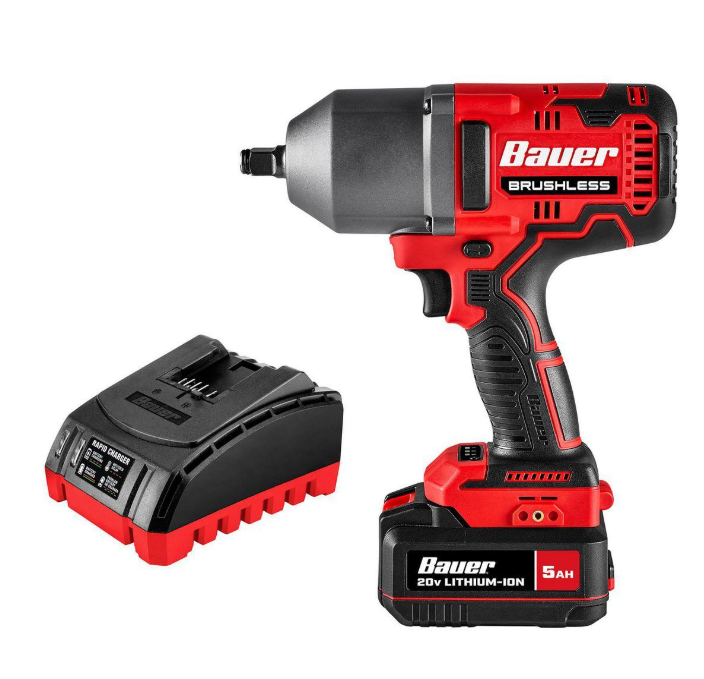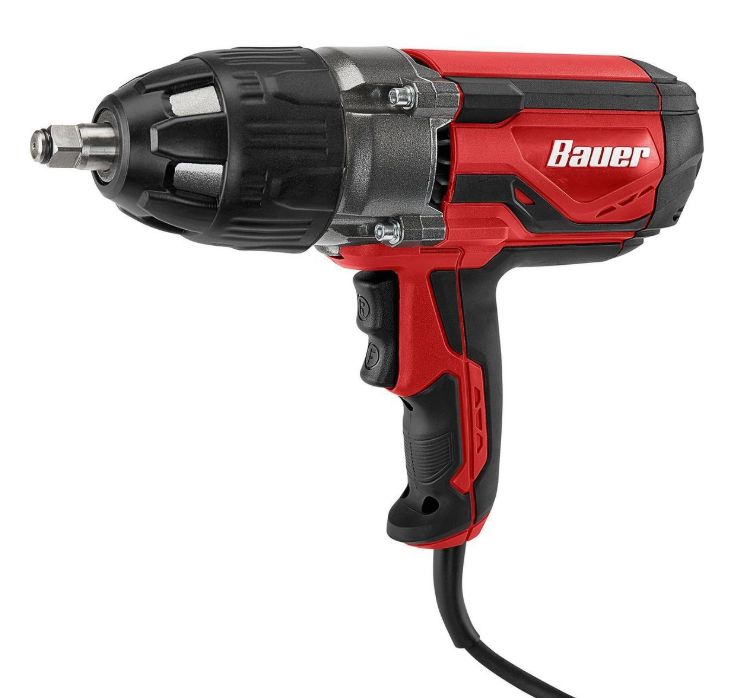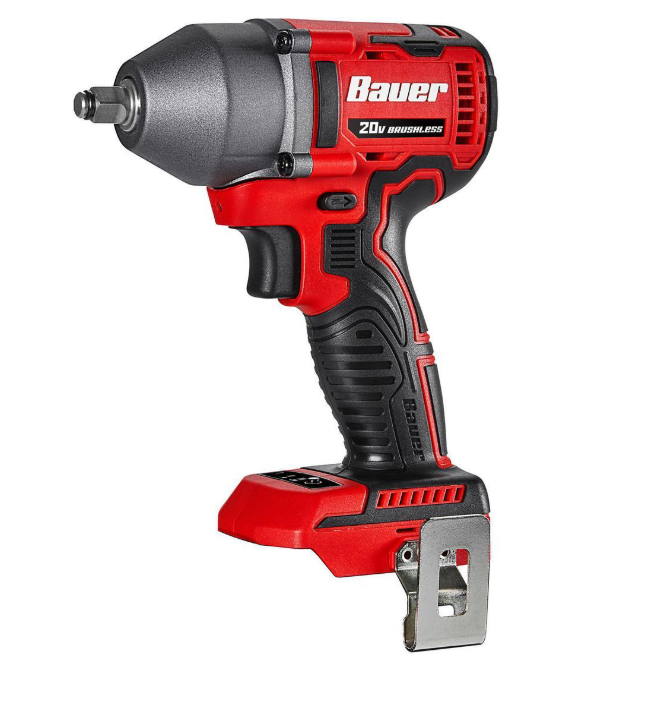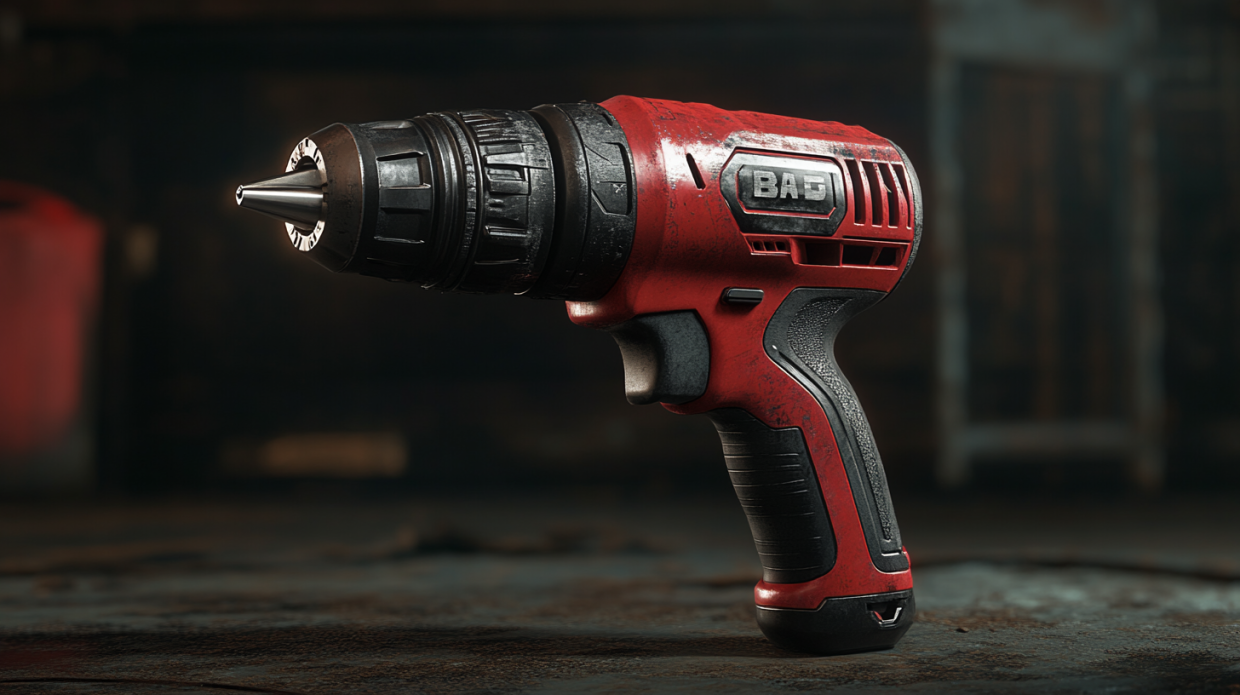
BAUER 20V Brushless Cordless, 1/2 in. High-Torque Impact Wrench Kit with 5 Ah Battery and Charger
- High-performance brushless motor delivers 1000 ft-lbs breakaway torque for the most demanding bolt removal jobs
- 1/2 in. square anvil drive with friction ring for secure socket retention
- 3-speed drive control button with LED indicator

BAUER 8.5 Amp, 1/2 in. Impact Wrench with Rocker Switch
- High-power 8.5 amp motor delivers 1050 ft-lbs bolt breakaway torque
- 1/2 in. anvil with heavy duty hog ring for secure socket retention
- All-metal gear construction for longer life and durability

BAUER 20V Brushless Cordless 3/8 in. 3-Speed Impact Wrench – Tool Only
- High performance brushless motor delivers 300 ft-lb of max torque for the most demanding applications
- 3/8 in. anvil with friction ring for secure socket retention
- Variable speed trigger for precision control
From Amateur to Pro: How This Affordable Powerhouse Is Changing the Game
There’s something deeply satisfying about that distinctive rat-tat-tat sound. The moment when stubborn bolts finally surrender, breaking free after what feels like an eternity of resistance. If you’ve ever struggled with a traditional wrench, arms burning and knuckles bloodied from a slipped socket, you understand the pure joy that comes from wielding a proper impact wrench. And when it comes to balancing performance with price, the Bauer impact wrench has become the unexpected hero in garages across America.
I still remember my first encounter with a Bauer. It was on a frigid Saturday morning, the kind where metal feels like it’s welded in place and every joint in your body protests against movement. My neighbor Tom was changing out his winter tires, and I was preparing for my usual two-hour battle with frozen lug nuts. Then I heard it—that beautiful mechanical chatter coming from his driveway. Ten minutes later, he was done. I was still trying to break loose my first nut with a breaker bar.
“Bauer,” he said simply, holding up a surprisingly compact cordless impact wrench. “Hundred and twenty bucks at Harbor Freight. Best money I’ve spent all year.”
That was three years ago. Now I’m the one finishing jobs in minutes instead of hours, and I’ve become something of an evangelist for these underrated tools. Let me take you deep into the world of Bauer impact wrenches, exploring everything from torque ratings to practical applications, and help you decide if this might be the next game-changing addition to your own toolbox.
What Exactly Is a Bauer Impact Wrench?
For the uninitiated, let’s start with the basics. A Bauer impact wrench is a power tool manufactured under the Bauer brand, which is exclusive to Harbor Freight Tools. It’s designed to deliver high torque output with minimal effort from the user through a hammering rotational mechanism.
Unlike a standard drill or driver that applies constant torque, an impact wrench uses a spring-loaded hammer and anvil system that delivers rapid rotational strikes (impacts) to the output shaft. This hammering action creates momentary peaks of torque much higher than what a continuous-rotation tool could provide, all while transferring minimal twist-back to your hands and wrists.
Think of it like the difference between pushing steadily against a stuck door versus using your shoulder to deliver quick, powerful bumps. The bumping technique often works better with less strain—that’s the impact mechanism at work.
Bauer offers both corded and cordless models, with the 20V cordless lineup being particularly popular among DIYers and professional mechanics alike. These tools occupy an interesting middle ground in the market—more affordable than premium brands like Milwaukee or DeWalt, yet offering performance that frequently surprises even seasoned professionals.
The Power Factor: Torque Capabilities
When it comes to impact wrenches, torque is king. It’s the rotational force that determines whether you’ll effortlessly spin off that rusted bolt or end up cursing in your driveway. The Bauer lineup doesn’t disappoint in this department.
The flagship 20V 1/2-inch cordless impact wrench delivers an impressive 1,050 ft-lbs of breakaway torque and 700 ft-lbs of fastening torque. For context, that’s enough power to handle lug nuts on most passenger vehicles, light trucks, and even some heavy equipment.
“But what does that really mean in practical terms?” you might ask.
Consider this: most passenger car lug nuts require between 80-100 ft-lbs of torque. Light truck lug nuts might call for 100-150 ft-lbs. The Bauer’s 700 ft-lbs of fastening torque gives you more than enough power for these tasks, while the 1,050 ft-lbs of breakaway torque provides that crucial extra oomph for removing seized or over-tightened fasteners.
I’ve personally used my Bauer to break loose lug nuts that had been overtightened by an overzealous tire shop with a pneumatic impact wrench. That’s legitimately impressive performance for a tool in this price range.
It’s worth noting that Bauer also offers a compact 3/8-inch model with slightly less torque (450 ft-lbs) but greater versatility for working in tight spaces, as well as a corded 7.5-amp model that delivers consistent power without battery concerns.
Automotive Applications: A DIY Mechanic’s Best Friend
If you’re wondering whether the Bauer impact wrench is suitable for automotive work, the short answer is a resounding yes. In fact, this is where these tools truly shine.
From routine maintenance like tire rotations and brake jobs to more involved repairs such as suspension work or exhaust system replacements, a good impact wrench can reduce hours of labor to mere minutes. The Bauer models handle these tasks with aplomb.
Take lug nuts, for instance. What might take 5-10 minutes of straining with a lug wrench can be accomplished in seconds with the Bauer. This isn’t just about convenience—it’s about safety too. Ever had a lug wrench slip while you’re putting your full weight into it? The resulting scraped knuckles and occasional face-plant into your wheel well aren’t experiences anyone wants to repeat.
The Bauer’s compact design also makes it maneuverable in tight engine bays. I’ve used mine to remove stubborn crankshaft pulleys, alternator bolts, and suspension components that would have been nightmarish with hand tools.
One particularly memorable project involved removing the exhaust manifold bolts on my brother-in-law’s 2007 F-150—bolts notorious for seizing after years of heat cycles. After soaking them in penetrating oil overnight, the Bauer made quick work of what could have been hours of frustration with manual wrenches and damaged hardware.
That said, there are limitations. While the Bauer can handle most automotive tasks admirably, extremely high-torque applications like axle nuts on some heavy-duty vehicles might still require a trip to a professional shop with industrial-grade equipment. Know your tool’s limits, and you’ll rarely be disappointed.
Value Proposition: Cost vs. Performance
One of the most compelling aspects of the Bauer impact wrench is its price-to-performance ratio. The 20V 1/2-inch cordless model typically retails for around $99-$129 for the bare tool, or $169-$199 for a kit including a battery and charger.
To put this in perspective, comparable models from premium brands can easily cost $200-$300 for the bare tool alone, with complete kits approaching or exceeding $400. Yet in many real-world applications, the performance gap doesn’t match the price difference.
I’ve had the opportunity to use impact wrenches from across the price spectrum, and while there are certainly differences in build quality, ergonomics, and features, the fundamental question is whether the tool does what you need it to do. For most DIYers and even many professionals, the Bauer hits a sweet spot where the performance is more than adequate for the tasks at hand, while the price remains accessible.
This value proposition becomes even more attractive when you consider Harbor Freight’s frequent sales and coupon offerings, which can sometimes bring the price of these tools down even further.
Of course, there’s always the question of durability and longevity. While early Bauer tools had mixed reputations, the current generation has shown significant improvements in quality control and durability. Many users report several years of reliable service, even under semi-regular use.
Availability: Where to Find Your Bauer
Unlike some tool brands that are distributed through multiple retailers, Bauer is exclusive to Harbor Freight Tools. This exclusivity has both advantages and disadvantages.
On the positive side, Harbor Freight’s widespread presence—with over 1,300 stores across the United States—means most consumers are within reasonable driving distance of a location. Their expansion continues at a rapid pace, adding dozens of new stores annually.
The company also offers online shopping with shipping options, though their e-commerce experience has historically lagged behind some competitors. Recent improvements have made the online shopping experience more user-friendly, with clearer product information and more reliable shipping estimates.
The exclusivity does mean you won’t find these tools at your local home improvement chain or online marketplaces directly from the manufacturer. However, secondary markets like eBay and Facebook Marketplace often have used or sometimes new-in-box Bauer tools available.
For warranty service or replacement parts, this single-retailer approach streamlines the process—there’s no confusion about where to go for support. Harbor Freight’s in-store returns and exchanges are typically straightforward, though experiences can vary by location.
Power Source Options: Corded vs. Cordless
Bauer offers both corded and cordless impact wrenches, each with distinct advantages for different use cases.
The cordless models run on Bauer’s 20V lithium-ion battery platform and offer the obvious benefit of portability. You can easily move around a vehicle without managing a cord, work in locations without power access, or quickly grab the tool for a fast job without hunting for an outlet and extension cord.
Battery life on the cordless models is respectable, especially with the larger capacity packs. With the standard 1.5Ah battery, expect to remove and reinstall the lug nuts on 3-4 vehicles before needing a recharge. The larger 5.0Ah battery can handle significantly more work—often a full day of intermittent use for most DIYers.
The cordless models also tend to be more compact and lighter without the cord, making them easier to maneuver in tight spaces. However, they do require an investment in batteries and chargers if purchased as a bare tool.
The corded Bauer impact wrench, by contrast, offers unlimited runtime as long as you have power available. This makes it ideal for shop settings where you’ll be working in a fixed location and might use the tool for extended periods. At 7.5 amps, it delivers consistent power without the gradual performance drop that can occur as batteries deplete.
The corded model is also typically less expensive than a complete cordless kit, making it an economical choice for users who don’t need portability or already have a compressor and pneumatic tools.
For most home users, the cordless model offers greater versatility, but the corded option remains a viable choice for workshop settings or users on tighter budgets.
Competitive Landscape: How Does Bauer Stack Up?
The impact wrench market is crowded with options across various price points, from budget-friendly brands to professional-grade tools costing several times more. How does Bauer compare to these alternatives?
At the premium end of the spectrum, brands like Milwaukee, DeWalt, and Makita offer impact wrenches with marginally higher torque ratings, more refined ergonomics, and additional features like multiple speed settings, better LED lighting, and more sophisticated electronic controls. They also tend to have more comprehensive warranty coverage and established reputations for durability in professional environments.
In the mid-range, brands like Ryobi and Craftsman offer similar performance to Bauer at comparable or slightly higher price points. These tools often benefit from wider distribution networks and compatibility with more extensive battery platforms that include dozens of tools.
At the budget end, various lesser-known brands offer impact wrenches at similar or lower prices than Bauer, but often with significantly compromised performance, durability, or both.
Where Bauer carves out its niche is in offering near-premium performance at a distinctly mid-range price. In controlled tests, Bauer impact wrenches often deliver 80-90% of the performance of tools costing twice as much or more. For occasional to moderate use, this makes them an extremely attractive option.
That said, professional users who depend on their tools daily may find the investment in premium brands worthwhile for the incremental improvements in ergonomics, durability, and warranty coverage. The decision ultimately comes down to your personal use case and budget constraints.
Compatibility and Accessories: Getting the Right Fit
When it comes to sockets and accessories, the Bauer impact wrenches follow industry standards for compatibility. The most popular model features a 1/2-inch square drive, which is the most common size for automotive and general mechanical work.
This standardization means you can use any 1/2-inch impact sockets with your Bauer wrench. Important note: Always use impact-rated sockets with impact wrenches. Regular chrome sockets can shatter under the hammering forces, creating dangerous projectiles.
Bauer also offers a 3/8-inch model for lighter-duty applications and work in tighter spaces. This size is perfect for smaller fasteners and more detailed work where the bulkier 1/2-inch model might be overkill.
For those needing to adapt between sizes, square drive adapters are readily available and affordable. A 1/2-inch to 3/8-inch adapter, for instance, allows you to use smaller sockets with your larger impact wrench when needed.
Beyond basic sockets, the standard square drive allows compatibility with extensions, universal joints, and specialty sockets for wheel locks, spark plugs, and other application-specific needs.
For the cordless models, batteries and chargers deserve special mention. Bauer’s 20V batteries are interchangeable across the entire Bauer 20V platform, which includes drills, saws, lights, and other tools. This compatibility can make the initial investment in batteries and chargers more economical if you plan to expand your collection of cordless tools over time.
What’s in the Box: Batteries, Chargers, and Warranty
Bauer impact wrenches are available in several packaging options, which affects what’s included with your purchase.
The most economical option is the “bare tool” package, which includes only the impact wrench itself—no battery or charger. This option makes sense if you already own other Bauer 20V tools and have compatible batteries and chargers.
The standard kit typically includes the impact wrench, one 1.5Ah battery, and a charger. This provides everything needed to get started, though the smaller battery may limit runtime for extended jobs.
Premium kits sometimes include larger capacity batteries (up to 5.0Ah) or multiple batteries, providing extended runtime for more demanding applications.
As for warranty coverage, Bauer tools currently come with a 90-day satisfaction guarantee and a 2-year limited warranty against defects in materials and workmanship. This is shorter than the 3-5 year warranties offered by premium brands, but reasonable for the price point.
Harbor Freight also offers extended protection plans at additional cost, which can extend coverage up to 2 additional years. Whether these plans represent good value depends on your intended use and risk tolerance.
It’s worth noting that Harbor Freight’s warranty service is typically handled in-store, which can be more convenient than the mail-in service required by some online-only brands. Bring your tool, proof of purchase, and valid ID to your local store for assistance with warranty claims.
Real-World Performance: Taking on Tough Jobs
Theory and specifications are useful, but nothing beats real-world performance when evaluating tools. So how does the Bauer impact wrench handle challenging tasks?
Lug nut removal is perhaps the most common application, and here the Bauer excels. Even lug nuts torqued to specification (typically 80-100 ft-lbs) come off easily, usually with less than a second of impact time. Over-tightened lug nuts may require 2-3 seconds of impact, but rarely stall the tool completely.
Suspension work often involves larger bolts subjected to years of corrosion and stress. On control arm bolts, ball joint fasteners, and shock mounts, the Bauer generally performs admirably, though particularly stubborn fasteners may require penetrating oil and patience. In extreme cases of seized fasteners, even professional-grade tools can struggle, so this isn’t a Bauer-specific limitation.
Engine bay applications like accessory brackets, intake manifolds, and exhaust components are generally well within the Bauer’s capabilities. The tool’s size can sometimes be limiting in extremely tight engine compartments, but this is a common challenge with any 1/2-inch impact wrench.
For home projects beyond automotive work, the Bauer proves surprisingly versatile. Lag bolts for deck construction, concrete anchors, and structural hardware are no match for its power. I’ve even used mine with a special adapter to drive ground screws for a fence installation—a task that would have been backbreaking with manual tools.
Where you might notice limitations compared to premium brands is in sustained heavy-duty use. During extended sessions, the Bauer may run slightly hotter than more expensive competitors, and battery life might not quite match the marathon runtime of top-tier models with equivalent battery capacity.
Safety First: Proper Use and Precautions
With great power comes great responsibility, and impact wrenches demand respect. These tools can generate enough torque to cause injury or damage if used improperly.
Always wear appropriate safety gear when operating an impact wrench. This includes:
- Safety glasses or a face shield to protect against fragments or debris
- Hearing protection (impact wrenches are loud!)
- Work gloves to protect your hands and improve grip
Beyond personal protection, proper technique is crucial:
- Ensure the socket is fully seated on the fastener before applying power
- Keep firm control of the tool, anticipating the initial torque reaction
- Don’t rely on the impact wrench for final tightening—always use a torque wrench to achieve proper specifications
- When removing lug nuts, loosen them in a star pattern and back the vehicle down only after all nuts are secure
For automotive applications, remember that impact wrenches are primarily removal tools. While they can be used for installation, final tightening should always be done with a properly calibrated torque wrench to manufacturer specifications.
Be particularly cautious with plastic components, aluminum fasteners, or other soft materials that can be easily damaged by the powerful hammering action of an impact wrench.
Finally, respect the limitations of your specific model. While the Bauer is capable, there are extremely high-torque applications where it may not be the appropriate tool. Forcing the tool beyond its capabilities can lead to damage or injury.
Maintenance and Longevity: Keeping Your Bauer Running
Like any tool investment, proper maintenance can significantly extend the useful life of your Bauer impact wrench. Fortunately, these tools require minimal maintenance compared to many others in your arsenal.
For the tool itself:
- Regularly clean dust and debris from the housing using compressed air or a soft brush
- Check and clean the anvil (the square drive end) periodically, removing any dirt or metal particles
- Inspect the hammer mechanism by listening for unusual sounds during operation
- Ensure proper ventilation during use to prevent overheating
For cordless models, battery care is equally important:
- Store batteries at room temperature, avoiding extreme heat or cold
- Don’t leave batteries on the charger indefinitely after charging is complete
- Allow hot batteries to cool before charging
- Periodically fully discharge and recharge batteries to maintain optimal performance
One area where impact wrenches differ from many other power tools is lubrication. The hammer mechanism benefits from occasional oil application. Some users report improved performance and longevity by applying a few drops of air tool oil to the anvil area every few months of regular use.
As for replacement parts, consumable components like motor brushes, switches, and battery contacts are generally available through Harbor Freight’s parts department. More substantial repairs might be better handled through warranty service while coverage remains in effect.
With proper care, many users report several years of reliable service from their Bauer impact wrenches, making them an excellent value proposition even if they don’t quite match the decade-plus lifespan sometimes achieved by premium brands.
Impact Wrench vs. Impact Driver: Understanding the Difference
One common source of confusion for tool buyers is the distinction between impact wrenches and impact drivers. While they operate on similar principles, they’re designed for different applications.
An impact wrench like the Bauer models we’ve been discussing is specifically designed for high-torque applications involving nuts and bolts. It typically features a 1/2-inch or 3/8-inch square drive for attaching sockets and delivers maximum torque in the hundreds of foot-pounds.
An impact driver, by contrast, usually has a 1/4-inch hexagonal quick-change bit holder designed primarily for driving screws. Impact drivers typically deliver much less torque (usually measured in inch-pounds rather than foot-pounds) but operate at higher speeds, making them ideal for driving fasteners into wood or other materials.
Think of the impact wrench as the heavyweight champion—slower but incredibly powerful—while the impact driver is more of a welterweight contender with speed and agility but less raw power.
For automotive work, construction with large lag bolts, or other applications involving substantial nuts and bolts, an impact wrench is the appropriate tool. For building decks, installing drywall, or assembling furniture, an impact driver would be the better choice.
Many serious DIYers eventually acquire both, as they complement each other well in a complete tool collection. Bauer offers both types in their lineup, with similar price-to-performance advantages across the board.
The Verdict: User Reviews and Final Assessment
After thousands of units sold and years on the market, a clear picture of the Bauer impact wrench’s reputation has emerged through user reviews and professional assessments.
Online reviews consistently average around 4.3-4.6 out of 5 stars, with particular praise for:
- Impressive power-to-price ratio
- Reliable performance in real-world applications
- Decent battery life (for cordless models)
- Comfortable ergonomics for extended use
Common criticisms center around:
- Occasional quality control issues
- Limited advanced features compared to premium brands
- Shorter warranty period
- Battery compatibility limited to Bauer ecosystem
Professional reviewers tend to express pleasant surprise at the performance, often using phrases like “punches above its weight class” and “surprisingly capable.” Side-by-side comparisons with premium brands typically acknowledge the performance gap but question whether the difference justifies the substantial price premium for casual users.
My personal assessment after several years of ownership aligns with this consensus. For the average DIYer, weekend warrior, or even light professional use, the Bauer impact wrench represents one of the best values in the power tool market today. It delivers the essential performance needed for most applications without the premium price tag of more established brands.
For professionals who depend on their tools daily for income, the additional investment in premium brands may be justified by incremental improvements in durability, warranty coverage, and advanced features. But for the vast majority of users, the Bauer hits a sweet spot that’s hard to beat.
Conclusion: Is the Bauer Impact Wrench Right for You?
After this deep dive into all things Bauer impact wrench, the inevitable question remains: should you buy one?
If you’re a DIY mechanic, weekend warrior, or homeowner who occasionally tackles substantial projects, the answer is likely yes. The combination of accessible pricing and capable performance makes it an excellent entry point into the world of impact tools.
If you’re already invested in another battery platform with comparable tools, the decision becomes more nuanced. The convenience of sharing batteries across your tool collection might outweigh the potential savings of switching to Bauer for a single tool.
For professionals or extremely frequent users, the decision hinges on your specific needs and budget constraints. While many professionals do successfully use Bauer tools, the additional features and warranty coverage of premium brands may provide value that justifies their higher cost in high-use scenarios.
What’s undeniable is that tools like the Bauer impact wrench have democratized access to capable power tools, allowing more people to complete projects efficiently and safely without breaking the bank. That’s a win for the DIY community as a whole.
Whether you’re rescuing a stranded motorist with a flat tire, finally tackling that suspension upgrade you’ve been putting off, or simply making your seasonal tire rotations less of a chore, an impact wrench can be transformative. And the Bauer models make that transformation surprisingly affordable.
So next time you find yourself straining against a stubborn bolt or dreading a particular mechanical task, consider whether it might be time to add this particular tool to your arsenal. Your knuckles—and your schedule—will thank you.

